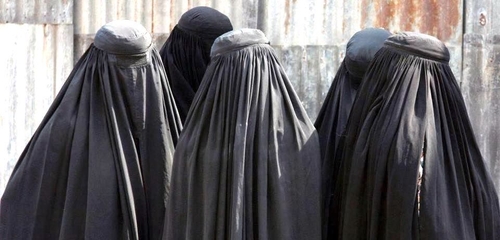The pictures from Abu Ghraib prison in Iraq touched such a nerve in the Muslim world that one analyst said that the rape pictures "would equal a nuclear explosion" if seen in Muslim countries. Such extreme reactions raise the delicate topic of sex in Muslim-Western relations.
 The West and the Muslim world entertain vastly different assumptions about female sexuality. (I draw here on the ideas of Fatema/Fatima Mernissi in her 1975 book, Beyond the Veil: Male-Female Dynamics in a Modern Muslim Society.) In the West, it was until recently assumed that males and females experience eros differently, with men actively undertaking the hunt, seduction, and penetration, and women passively enduring the experience. Only lately did the idea gain currency that women too have sexual desires.
The West and the Muslim world entertain vastly different assumptions about female sexuality. (I draw here on the ideas of Fatema/Fatima Mernissi in her 1975 book, Beyond the Veil: Male-Female Dynamics in a Modern Muslim Society.) In the West, it was until recently assumed that males and females experience eros differently, with men actively undertaking the hunt, seduction, and penetration, and women passively enduring the experience. Only lately did the idea gain currency that women too have sexual desires.
Considering the Muslim reputation for archaic customs, it is ironic to note that Islamic civilization not only portrays women as sexually desirous, but it sees them as more passionate than men. Indeed, this understanding has determined the place of women in traditional Muslim life.
In the Islamic view, men and women both seek intercourse, during which their bodies undergo similar processes, bringing similar pleasures. If Westerners traditionally saw the sexual act as a battleground where the male exerts his supremacy over the female, Muslims saw it as a tender and shared pleasure.
Indeed, Muslims generally believe female desire to be so much greater than the male equivalent that the woman is viewed as the hunter and the man as her passive victim. If believers feel little distress about sex acts as such, they are obsessed with the dangers posed by women. So strong are her needs thought to be, she ends up representing the forces of unreason and disorder. A woman's rampant desires and irresistible attractiveness gives her a power over men that even rivals God's. She must be contained, for her unbridled sexuality poses a direct danger to the social order. (Symbolic of this, the Arabic word fitna means both civil disorder and beautiful woman.)
The entire Muslim social structure can be understood as containing female sexuality. It goes to great lengths to separate the sexes and reduce contact between them. This explains such customs as the covering of women's faces and the separation of women's residential quarters, or the harem. Many other institutions serve to reduce female power over men, such as her need for a male's permission to travel, work, marry, or divorce. Revealingly, a traditional Muslim wedding took place between two men – the groom and the bride's guardian.
 Burqas: one way of keeping men and women apart. |
Even married couples should not get too attached; to insure that a man does not become so consumed with passion for his wife that he neglects his duties to God, Muslim family life restricts contact between the spouses by dividing their interests and duties, imbalancing their power relationship (she is more his servant than his companion), and encouraging the mother-son bond over the marital connection.
On the whole, Muslims lived up to these Islamic ideals for male-female relations in premodern times. Yet the anxiety persisted that women would break loose of their restrictions and bring perdition to the community.
Those anxieties multiplied in recent centuries as Western influence spread through the Muslim world, for Western ways nearly always collide with Islamic ones. The two are divided by the enhanced power and freedoms women have gained through legal equality, monogamy, romantic love, open sexuality, and a myriad other customs. As a result, each civilization looks upon the other as deeply flawed, if not barbaric.
For many Muslims, the West poses not just an external threat as the infidel invader; it also erodes traditional mechanisms to cope with the internal threat, woman. This leads to widespread worries about adopting Western ways and a preference instead to cling to older customs. Differences in sexuality, in other words, contribute to an overall Muslim reluctance to accept modernity. Fear of Western erotic ways ends up constraining Muslim peoples in the political, economic, and cultural arenas. Sexual apprehensions constitute a key reason for Islam's trauma in the modern era.
And this explains the extreme sensitivity to such varied matters as girls wearing the headscarf in French classrooms, "honor" killings in Jordan, women drivers in Saudi Arabia, and those pictures from Iraq's Abu Ghraib prison.
May 25, 2004 update: The above article summarizes a 2,700-word analysis in my 1983 book, In the Path of God. It can be read at "Male-Female Relations."
Nov. 30, 2015 update: Fatema Mernissi died this morning.
